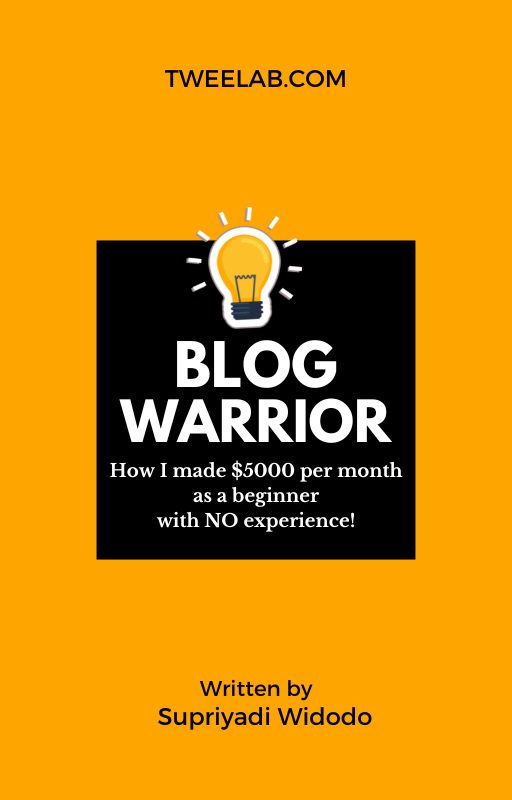Are you looking blogging for beginner but feeling overwhelmed by the sheer amount of information out there? Look no further! This article will give you 29 essential tips to help jumpstart your blog, get you on your way to success, and how to learn blogging for free.
First and foremost, it’s important to grab your readers’ attention with catchy headlines that accurately reflect the content of your post.
Knowing your audience is also crucial – tailoring your content to their interests will keep them coming back for more.
Utilizing keywords in your posts can also help improve search engine optimization and drive traffic to your site.
Remember, consistency is key in maintaining a successful blog; try setting a schedule for posting new content and stick to it.
And while it may be tempting to churn out as much content as possible, quality should always take precedence over quantity.
With these tips in mind, let’s dive into the world of blogging basics!
Use Catchy Headlines

Don’t underestimate the power of a catchy headline – it’s the first thing readers see and can make or break their decision to click and read more. A good headline should be concise, attention-grabbing, and relevant to your blog post.
To create an effective headline, try using numbers, posing a question, or making a bold statement. When brainstorming headlines, think about what would make you want to click on an article. What piques your interest? What promises valuable information?
Keep in mind that your headline should accurately reflect the content of your post – don’t mislead readers with a flashy title that doesn’t deliver on its promise. Your headline is also important for search engine optimization (SEO). Including keywords related to your topic can help improve your chances of showing up in search results.
However, don’t stuff too many keywords into your title – it should still be readable and appealing to human readers. By taking the time to craft a strong headline, you’ll increase the likelihood that people will find and engage with your content.
Know Your Audience

Understanding your readers is crucial to creating engaging content that resonates with them and keeps them coming back for more. As a blogger, it’s important to know who your target audience is and what they’re interested in. By understanding their needs and preferences, you can tailor your content to meet their expectations and keep them engaged.
One way to get to know your audience is by conducting surveys or polls on your blog or social media platforms. You can ask questions about their interests, preferences, and the type of content they would like to see more of. This information will help you create content that’s relevant and valuable to them.
Another way to understand your audience is by analyzing your blog’s analytics data. You can use tools such as Google Analytics or Jetpack Stats to track visitor behavior, demographics, and other metrics that will give you insight into who your readers are. With this information, you’ll be able to adjust your blogging strategy accordingly and improve engagement with your audience.
| Column 1 | Column 2 | Column 3 |
|---|---|---|
| Blogging basics | Blogging tips | How-to start a blog |
| Blogging for beginners | Know Your Audience | Engaging Content |
Knowing your audience is an essential component of successful blogging. By understanding what makes them tick, you can create compelling content that resonates with them on a deep level. Whether by conducting surveys or analyzing analytics data, taking the time to get to know your readers will pay dividends in the long run as you build a loyal following of engaged readers who appreciate what you have to say.
Utilize Keywords

To improve your blog’s visibility and attract more readers, you should start utilizing relevant keywords in your content. Keywords are the terms or phrases that people use when searching for information online. By incorporating these keywords into your blog posts, you increase the chances of your blog appearing at the top of search engine results pages (SERPs).
When choosing keywords to use in your blog posts, it’s important to consider what people are searching for. Use tools like Google Keyword Planner or SEMrush to find popular search terms related to your niche. Additionally, make sure that the keywords you choose are relevant to the content of each post and not just randomly inserted.
Remember that using too many keywords can harm rather than help your efforts. This is known as keyword stuffing and can result in penalties from search engines. A good rule of thumb is to aim for a keyword density of around 1-2% per post.
With these tips, you’ll be able to utilize keywords effectively and see an increase in traffic on your blog.
Don’t underestimate the power of utilizing relevant keywords in your blog posts! It can make all the difference when it comes to attracting new readers and growing your audience. By doing some research on popular search terms related to blogging tips, how to start a blog, blogging for beginners, blog hosting, and WordPress blogging – among other things – you’ll be better equipped to incorporate them into your content naturally and effectively. Remember: quality over quantity always wins out when it comes to keyword usage!
Resource Link: The Importance of Relevant Keywords in Blogging: A Comprehensive Guide
Consistency is Key

If you want to keep your readers engaged, it’s important to maintain a consistent schedule for publishing new content on your blog. Consistency is key when it comes to blogging, and there are several reasons why this is true.
Here are some introduction to blogging basics that can help you stay on track:
- Regular posting helps build trust with your audience. If they know they can expect new content from you on a regular basis, they’re more likely to return to your blog in the future.
- A consistent schedule can also help with search engine optimization (SEO). When search engines see that you’re regularly updating your site with fresh content, they may give your site a boost in rankings.
- By establishing a routine for yourself, you’ll make it easier to stay motivated and avoid burnout. When you know what’s expected of you each week or month, it can take some of the pressure off.
When starting a blog for beginners, consistency should be one of the first things you focus on. It’s easy to get excited about creating content at the beginning, but if you don’t have a plan in place for how often you’ll publish new posts, it’s easy to lose momentum.
Decide how often you’d like to post (once per week? twice per month?), and create an editorial calendar so that you have topics planned out ahead of time.
Of course, maintaining consistency isn’t always easy – life happens! But if something comes up and causes delays in publishing new posts, try not to stress too much about it.
Remember that blogging should be enjoyable – not another source of anxiety or stress in your life. As long as you’re doing your best and staying committed overall, occasional hiccups won’t derail all of your hard work building up your blog hosting platform over time.
Quality Over Quantity

Don’t sacrifice the quality of your blog posts for the sake of quantity – it’s better to publish less frequently but with valuable, engaging content. When it comes to blogging, quality should always come first.
Creating high-quality content means providing readers with something that is worth their time and attention. If you focus solely on publishing a large number of posts, you may end up sacrificing the quality of your content.
To ensure that your blog posts are top-notch, take advantage of the best blogging tools available. Many blogging offer features like spell-checking, image editing tools, and SEO optimization plugins that can help improve the overall quality of your content. You can also use these tools to create engaging visuals and graphics that complement your written content.
Finally, remember that monetizing a blog takes time and effort – it won’t happen overnight. Instead of focusing solely on advertising and affiliate marketing as ways to make money from your blog, focus on creating valuable content first.
By building up a loyal readership through high-quality content, you’ll be more likely to attract advertisers who want to reach your audience organically without compromising the integrity of your work. So don’t forget: when it comes to blogging basics, quality over quantity should always be at the forefront of your mind!
Use Visuals

Now that you know quality is better than quantity, let’s talk about making your blog visually appealing. You can’t expect people to read through a wall of text without any breaks or visual aids. That’s where visuals come in handy.
Using images, videos, and other types of media can make your blog visually captivating and enticing to readers. These visual elements help break up long blocks of text and create a more enjoyable reading experience. They allow readers to better understand your content and grasp information more easily.
However, it’s important to use visuals purposefully and ensure they are relevant and add value to your content. When selecting images, opt for high-quality visuals that are clear and properly sized. This ensures that they don’t slow down your website’s loading time, providing a seamless browsing experience for your readers.
By implementing these blogging tips and tricks for beginners, you can create a visually stunning blog that not only captures readers’ attention but also keeps them coming back for more. Remember, a well-designed and visually appealing blog can make a significant difference in establishing a strong connection with your audience.
Create A Compelling About Me Page

Crafting a captivating About Me page is crucial in building trust and connecting with your audience, so it’s essential that you showcase your personality and expertise while keeping it concise and engaging. Your About Me page should serve as an introduction to who you are and what you do. It should provide your readers with a glimpse into your world and help them understand why they should follow your blog.
To create a compelling About Me page, start by introducing yourself in the first person. Share some personal details about yourself that will allow your readers to connect with you on a deeper level. Next, highlight your expertise by sharing some of your professional accomplishments or experiences. This will help establish credibility and build trust with your readers.
Finally, end with a call-to-action that encourages readers to engage further with you or subscribe to your blog. You could also include links to other relevant pages on your website or social media platforms where they can learn more about you or stay connected. Remember, the key is to keep it concise, engaging, and relevant to the content on your blog. So take some time to craft an About Me page that truly reflects who you are as a blogger!
Tips for Creating a Compelling About Me Page
- Introduce Yourself: Begin by providing a brief introduction about yourself. Mention your name, background, and any relevant personal details that will help readers connect with you.
- Highlight Your Expertise: Emphasize your areas of expertise and showcase your skills or qualifications. This helps establish credibility and lets readers know why they should trust your content.
- End With a Call-to-Action: Conclude your About Me page with a clear call-to-action. This can be an invitation for readers to subscribe to your newsletter, follow your blog, or reach out for collaboration opportunities.
- Share Personal Details: While maintaining professionalism, consider sharing some personal details that humanize you and make you relatable. This could include hobbies, interests, or anecdotes that give readers a glimpse into your personality.
- Build Credibility & Trust: Use your About Me page to build credibility and trust with your audience. Include any relevant achievements, awards, or certifications that demonstrate your expertise in your field.
- Encourage Readers to Engage Further: Prompt readers to engage further with your content. Encourage them to leave comments, ask questions, or share their thoughts on your blog posts. This fosters a sense of community and interaction.
- Keep It Concise & Engaging: Keep your About Me page concise and engaging. Avoid lengthy paragraphs and instead use bullet points or short paragraphs to convey information effectively. Use a friendly and conversational tone to maintain reader interest.
- Relevant to Blog Content: Ensure that your About Me page is aligned with the overall theme and focus of your blog. It should complement your content and provide readers with an understanding of your expertise within that niche.
- Include Links to Relevant Pages/Social Media Platforms: Provide links to relevant pages on your blog or website, such as your portfolio, services, or other blog posts that showcase your work. Additionally, include links to your social media profiles to encourage readers to connect with you on different platforms.
By following these tips, you can create a compelling About Me page that effectively introduces yourself, establishes your expertise, and encourages readers to engage further with your content.
Crafting an About Me page may seem like just another task on your blogging checklist but remember, this is one of the most important pages on your website! By following blogging basics tips and creating a compelling About Me page, you’ll be able to build stronger connections with your audience and establish yourself as an authority in your niche. Don’t forget – authenticity is key! So be yourself, showcase your personality and let your readers get to know the real you. Happy blogging!
Encourage Reader Interaction

You can make your website more interactive by encouraging readers to leave comments and share their thoughts about the content. One way to do this is by asking questions at the end of your blog posts that invite readers to leave a comment with their answer or opinion. You could also encourage readers to share their own experiences related to the topic you wrote about, or ask for feedback on what they’d like to see more of in future posts.
Another way to encourage reader interaction is by responding promptly and thoughtfully to comments left on your blog. When someone takes the time to leave a comment, it’s important that they feel heard and valued. Responding with a thank you or follow-up question shows that you appreciate their input and are interested in continuing the conversation.
Finally, consider hosting contests or giveaways on your blog as another method of encouraging engagement from your readers. Whether it’s offering a prize for leaving a thoughtful comment or sharing your post on social media, contests can be an effective way not only of driving traffic but also engaging with those who’ve already found your site.
By giving back to your audience in this way, you’ll foster a sense of community around your blog and create loyal followers who’re invested in its success.
Optimize Your Blog For Mobile Devices

If you want your readers to have a seamless experience when accessing your blog, make sure it’s optimized for mobile devices. With the increasing number of people accessing the Internet using their smartphones and tablets, it’s crucial that your blog is easily accessible on any device.
Here are three things you can do to optimize your blog for mobile devices:
- Use a responsive design: A responsive design ensures that your website adapts to different screen sizes and resolutions. This means that no matter what device someone is using to access your blog, they will be able to view it without any issues.
- Simplify navigation: When someone accesses your blog on a mobile device, they may not have the same amount of space as they would on a desktop computer or laptop. To ensure that navigation is easy, simplify the menu options and keep them clear and concise.
- Optimize images: Large images can slow down load times, which can be frustrating for anyone trying to access your blog from a mobile device with slower internet speeds. Optimize all images on your site so that they load quickly and don’t slow down the user experience.
Incorporating these blogging basics tips will go a long way in ensuring that readers can access and navigate through your content with ease, regardless of what type of device they’re using. By optimizing for mobile devices, you’ll not only improve user experience but also attract more readers who prefer browsing blogs on their smartphones or tablets. So go ahead and make those changes today!
Leverage Social Media

By leveraging social media, bloggers can increase their reach and connect with a wider audience. Social media platforms like Twitter, Facebook, LinkedIn, and Instagram are great tools that bloggers can use to promote their blog posts and engage with readers.
The key is to choose the right platform for your niche and target audience. To effectively leverage social media, you need to have a clear strategy in place. Start by creating profiles on the platforms where your audience is most active. Then, share your blog posts on these platforms using catchy headlines, attention-grabbing images or videos, and relevant hashtags.
Engage with your followers by responding to comments or messages promptly and sharing valuable content from other sources as well. In addition to promoting your own blog posts, you can also use social media to build relationships with other bloggers in your niche.
Share their content on your profiles when it’s relevant and tag them in your posts. This can help you establish yourself as an expert in your field and attract more followers to your blog over time. By consistently using social media strategically, you can grow both your blog’s traffic and its community of engaged readers.
Guest Post on Other Blogs

One effective way to expand your reach and gain exposure for your content is through guest blogging on other relevant blogs. By contributing high-quality content to a blog that caters to the same audience as yours, you can introduce yourself and your brand to a new set of readers who are already interested in what you have to say.
Plus, writing for other blogs also gives you an opportunity to showcase your expertise and establish yourself as an authority figure in your niche. To get started, look for blogs that cover similar topics or industries as yours. Make sure they have engaged readership and a good social media following.
Reach out to the blog owner or editor with a pitch about the kind of post you would like to contribute. Be sure to highlight why their audience will find it valuable, how it aligns with their editorial calendar, and why you’re uniquely qualified to write it. Once you’ve secured a guest post spot, make sure you deliver top-notch content that’s tailored specifically for their audience.
Follow their style guide, adhere to their word count requirements, and use visuals if possible. Don’t forget to include bio information at the end of your post with links back to your own website or blog so readers can easily find more of your work.
By guest posting regularly on different blogs within your niche, you’ll be able to widen your online presence even further and attract more traffic back home!
Network with Other Bloggers

Connect with fellow bloggers to grow your audience and build meaningful relationships that can lead to exciting collaborations and opportunities. Networking with other bloggers is a great way to expand your reach and gain exposure for your blog. You can start by following blogs in your niche, engaging with their content through comments and social media, and reaching out to them for potential collaborations or guest posting opportunities.
One effective way to network with other bloggers is by joining online blogging communities or groups. These platforms allow you to connect with like-minded individuals who share similar interests and goals. You can participate in discussions, share your blog posts, ask for feedback, and offer support to others. By being an active member of these communities, you not only get the chance to promote your blog but also learn from other bloggers’ experiences.
Another way to network with other bloggers is by attending blogging conferences or events. These gatherings provide a great opportunity for you to meet face-to-face with fellow bloggers, industry experts, brands, and sponsors. You can attend workshops and sessions related to blogging topics that interest you, interact with speakers during Q&A sessions or networking breaks, exchange business cards or contact information with attendees that resonate with you. By investing time in building genuine relationships at these events, you may open doors for future partnerships or sponsorships that benefit both parties involved.
| Pros | Cons | Tips |
|---|---|---|
| Opportunity for collaboration | Risk of rejection | Be professional & respectful |
| Gain exposure & traffic | Time-consuming | Follow up after meetings |
| Learn from others’ experiences | Cost of attendance/traveling expenses | Set realistic expectations |
Remember that networking takes time and effort; it’s not something that happens overnight. Be patient yet persistent in building relationships within the blogging community as they can lead to exciting opportunities beyond just growing your audience!
Pay Attention to Formatting

Don’t underestimate the power of good formatting – it can make or break the readability and engagement of your content! When you create blog posts, remember that readers are more likely to skim through them than read every word.
Therefore, make sure you use headings, subheadings, bullet points, and bold text to highlight important information. By doing so, you’ll help your readers navigate through your content quickly and find what they’re looking for.
Another key aspect of formatting is using images and videos throughout your blog post. Not only do they break up large chunks of text, but they also make your content more visually appealing. Choose high-quality images that are relevant to your topic and add captions or alt tags for SEO purposes.
Videos can also be a great way to engage with your audience; consider creating short clips that provide additional context or showcase examples related to your blog post.
Lastly, don’t forget about mobile optimization when it comes to formatting. With more people accessing the internet on their smartphones than ever before, it’s crucial that your blog is easy to read on smaller screens. Use responsive design techniques so that your website adapts to different screen sizes automatically. Additionally, avoid using too many pop-ups or ads that could slow down load times or interfere with navigation on mobile devices.
By paying attention to formatting details like these, you’ll ensure that your blog posts are easy-to-read and engaging for all types of readers – whether they’re skimming quickly on a desktop computer or scrolling through their phone during a commute. So take some time to experiment with different formats until you find what works best for you!
Use Internal Linking

Using internal linking is a great way to boost your website’s SEO and keep readers engaged with your content. Internal linking refers to the practice of including links within your blog posts that lead to other pages on your website. By doing this, you not only make it easier for readers to navigate through your site, but you also provide search engines with additional information about the structure of your website.
One way to effectively use internal linking is by creating a pillar page or hub page that serves as a central point of reference for related content on your site. This page should be optimized for SEO and contain links to other relevant pages on your site. By doing this, you not only make it easier for readers to find related content, but you also signal to search engines that these pages are important and should be given more weight in search results.
Another strategy is to link back to older posts within new blog content. This not only provides readers with additional context but can also help improve the visibility of older posts. It’s important, however, not to overdo it and include too many links in one post. Aim for 2-3 internal links per post and make sure they are relevant and add value to the reader’s experience. By using internal linking strategically, you can improve both user engagement and SEO performance on your site.
| Emotion | Example | Explanation |
|---|---|---|
| Humor | “Don’t be afraid of using internal links – they won’t bite! In fact, they might just bring some life into those old blog posts gathering dust.” | Using humor can create a more lighthearted tone while still conveying useful information about the topic at hand. |
| Curiosity | “Did you know that incorporating internal links could boost traffic on older blog posts? Keep reading to learn more!” | Piquing readers’ curiosity can encourage them to continue reading in order to gain new insights or knowledge. |
| Inspiration | “By using internal links effectively, you can create a seamless user experience that keeps readers coming back for more. Start implementing these tips today and watch your website grow!” | Inspiring readers to take action can motivate them to implement the strategies discussed in the post, leading to positive results for their own blogs. |
Optimize Your Blog’s Loading Speedip

Improving your blog’s loading speed is crucial for enhancing user experience and boosting SEO performance. Nobody wants to wait around for a website to load, especially when there are plenty of other options out there. Slow loading times can increase bounce rates and decrease page views, ultimately hurting your blog’s traffic and potential revenue.
To optimize your blog’s loading speed, consider the following blogging basics tips:
- Use a content delivery network (CDN) to distribute your content across multiple servers.
- Compress images and videos to reduce file size without sacrificing quality.
- Minimize HTTP requests by combining files and scripts whenever possible.
- Utilize browser caching to store frequently accessed data on the user’s device.
By implementing these strategies, you can significantly improve your blog’s loading speed and create a more enjoyable experience for your readers. Not only will this boost engagement and retention rates, but it’ll also help with SEO rankings as Google takes into account page speed as a ranking factor.
Remember that optimizing for faster loading times is an ongoing process that requires regular monitoring and adjustments. Keep testing different methods until you find what works best for your specific blog setup and audience needs. By prioritizing user experience through efficient site speeds, you’ll set yourself up for long-term success in the competitive world of blogging.
Learn Basic SEO Principles

You can’t afford to ignore basic SEO principles if you want your blog to succeed, so start learning and implementing them now!
Blogging basics tips abound online, but one of the most important ones is to optimize your content for search engines. Basic SEO principles include identifying relevant keywords and incorporating them into your blog posts in a natural way. This helps search engines understand what your content is about and rank it higher in search results.
When starting a blog, it’s also crucial to choose the right blog hosting platform that supports SEO. Some platforms may limit your ability to customize URLs or add meta descriptions, which are important elements for optimizing your content. Do some research on different blogging software before deciding on one that fits your needs.
Remember that basic SEO principles are only the beginning of optimizing your blog for search engines. Keep learning and experimenting with different techniques as you grow your blog. With persistence and dedication, you can improve your blog’s visibility and attract more readers over time.
Monitor Analytics

By tracking your blog’s performance through analytics, you can gain valuable insights into the behavior and preferences of your audience. Monitoring analytics is one of the most important aspects of running a successful blog.
The data collected from analytics tools can help you make informed decisions about how to optimize your content, improve user engagement, and increase traffic to your site. Here are three sub-lists that highlight the benefits of monitoring analytics for bloggers:
- Understand Your Audience: By analyzing metrics such as page views, bounce rates, and time on site, you can gain a better understanding of who’s visiting your blog and what they’re interested in. This information allows you to create content that resonates with your target audience.
- Identify Popular Content: Analytics tools can show you which pages or posts on your blog are generating the most traffic. You can use this information to replicate successful content strategies in future posts or update older articles to keep them relevant.
- Measure Success: By setting goals for your blog and tracking progress through analytics, you can measure success over time. This data helps you understand what’s working well and where improvements need to be made.
Whether you’re using popular blogging application like WordPress or looking for the best blogging tools to monetize a blog, monitoring analytics should be an integral part of your strategy. With so much competition in the digital space today, it’s essential to stay ahead of the curve by understanding what works best for your audience.
Incorporating regular analysis of website traffic patterns and user behaviors allows bloggers to make data-driven decisions that lead to more engaged readership and higher conversion rates. So start tracking those metrics today!
Write Compelling Meta Descriptions

Crafting attention-grabbing meta descriptions is essential for capturing the interest of potential readers scrolling through search engine results pages. It’s what sets your blog apart from others and entices readers to click on it.
Your meta description should be a brief summary of your blog post, highlighting its main points and encouraging readers to read further. It should also include relevant keywords that are related to your content.
To write compelling meta descriptions, you need to understand your target audience and what they’re looking for. Use language that resonates with them and addresses their pain points or interests. Remember that your meta description is essentially an advertisement for your blog post, so make sure it stands out among other search results.
When it comes to optimizing your meta description, there are various best practices you can follow. For instance, keep it between 150-160 characters long, as this is the maximum length that will display in search engine results pages. Additionally, make sure it accurately reflects the content of your blog post and avoid using clickbait tactics or misleading information just to get clicks.
Incorporating these blogging basics tips into crafting a great meta description is vital if you want to drive traffic towards your blog posts organically. By doing so, you’ll increase the chances of ranking higher in search engines like Google, which can lead to more visibility online and ultimately help with monetizing a blog in the long run, whether you’re on the WordPress blogging platform or any other popular blogging out there today!
Proofread and Edit

Before hitting publish, make sure to thoroughly proofread and edit your blog post for grammar, spelling, and punctuation errors to ensure a polished final product. Nothing turns off readers more than seeing grammatical mistakes or typos in an article. It creates a bad impression on the reader and makes them question the credibility of the writer.
To avoid such situations, always take some time out to read through your blog post before publishing it. Proofreading not only involves checking for spelling and grammatical errors, but also making sure that your content is well-structured and flows smoothly. It’s essential to make sure that each paragraph is connected to the one before it and after it, so that there are no awkward transitions.
Additionally, check for any factual errors or inconsistencies in your writing. Make sure you’ve cited sources properly if you’ve used data or quotes from other sources. One way to ensure that you don’t miss anything during proofreading is by creating a checklist of things you need to look out for while editing. For example, start with checking spellings and grammar, followed by reading each sentence aloud to see how they sound.
You can also ask someone else to read your post, as fresh eyes can often spot mistakes that we may miss on our own. Remember, taking some extra time out for proofreading can go a long way in improving the quality of your blog posts!
Optimize Your Images

Make your blog visually appealing and grab your readers’ attention by optimizing images with descriptive titles, alt tags, and compressed file sizes. Images are not only aesthetically pleasing but also help break up long blocks of text.
However, you need to make sure that your images are optimized for the web so that they load quickly and don’t slow down your website’s loading time.
One way to optimize your images is by using descriptive titles and alt tags. Not only does this improve accessibility for those using screen readers, but it also helps search engines understand what the image is about. Make sure to include relevant keywords in your title and alt tag without overstuffing them.
Another important aspect of optimizing images is compressing their file size. Large image files can significantly slow down page load times, which can negatively impact user experience and even affect how Google ranks your website in search results. Use an image compressor tool or plugin to reduce the size of your image files without sacrificing quality.
By optimizing your blog’s images, you can improve its overall appearance and user experience while also potentially boosting its search engine ranking.
Use Categories and Tags

To help organize your content, you’ll want to use categories and tags.
Categories are broad topics that your blog posts can be grouped into. For example, if you have a food blog, you might have categories like ‘recipes’, ‘restaurant reviews’, and ‘cooking tips’.
Tags are more specific labels that describe the content of individual blog posts. Using tags allows readers to easily find related content on your blog.
Here are three blogging basics tips for effectively using categories and tags on your blog:
- Keep it simple: Don’t create too many categories or use too many tags per post. This will make it difficult for readers to navigate your blog and find what they’re looking for.
- Be consistent: Use the same category names and tag formats throughout your entire blog. This will make it easier for readers to understand how your content is organized.
- Use keywords: When choosing category names and tags, think about what words people might search for when trying to find content like yours. Including relevant keywords in your categories and tags can improve SEO (search engine optimization) for your blog.
By using categories and tags effectively, you can help readers easily navigate through the content on your blog and discover related articles that they may find interesting. Just remember to keep it simple, be consistent with naming conventions, and include relevant keywords for improved SEO.
Include a Call-To-Action (CTA)

You don’t want your readers to leave your blog without taking action, so including a call-to-action (CTA) is a must. A CTA is simply an instruction that urges your readers to take a specific action on your blog. It could be as simple as asking them to leave a comment, share the post, or subscribe to your newsletter.
Here’s a table with four examples of CTAs you can use in different situations:
| CTA | Purpose |
|---|---|
| Sign up for our newsletter | To grow your email list |
| Leave a comment below | To encourage engagement and conversation |
| Share this post on social media | To increase visibility and reach |
| Check out our products/services | To drive sales and revenue |
Incorporating CTAs into your blog posts can make all the difference in terms of reader engagement, traffic, and conversions. Remember to keep them clear, concise, and relevant to the topic at hand.
So next time you’re crafting a blog post, make sure you include one or more CTAs that align with your goals and objectives. By doing so, you’ll not only provide value to your readers but also move them closer towards becoming loyal followers or customers.
Research Trending Topics

Discovering what’s hot in your industry can help boost your blog’s popularity and keep your readers engaged. But how do you find these trending topics?
One way is to use social media platforms like Twitter, Facebook, and LinkedIn. Look for hashtags related to your niche and see what people are talking about.
Another way is to use Google Trends. This tool shows you the popularity of specific search terms over time. You can also narrow it down by location, category, and even type of search (i.e., web search, image search). By using this tool, you can identify which topics are currently popular and create content around them.
Lastly, don’t forget to check out other blogs in your industry. See what their most popular posts are and try to put your own spin on those topics. It’s important to stay current with trends but also add something unique that sets you apart from the rest.
By researching trending topics regularly, you’ll be able to create content that resonates with your audience and keeps them coming back for more.
Respond to Comments

Interacting with your readers through thoughtful responses to their comments can help establish a sense of community and foster engagement on your blog. Responding to comments shows that you value your readers’ opinions and are willing to engage in conversation with them. When readers feel heard, they are more likely to return to your blog, comment again, and even share your content with others.
To make the most out of responding to comments on your blog, it’s important to have a strategy in place. One way to do this is by creating a table that lists different types of comments and how you can respond to each one. For example:
| Comment Type | Response Strategy |
|---|---|
| Positive feedback | Thank the reader for their kind words and acknowledge their support |
| Constructive criticism | Thank the reader for their input and address any specific points they mentioned |
| Negative feedback | Respond calmly and professionally, addressing any valid concerns while respectfully disagreeing if necessary |
By having a plan in place for how you’ll respond to different types of comments, you’ll be better equipped to handle any feedback that comes your way.
Finally, remember that responding to comments isn’t just about replying directly on your blog – it’s also important to engage with readers on social media platforms where you share your content. By actively engaging with followers across multiple channels, you’ll be able to grow an even stronger community around your blog.
Utilize Email Marketing

When it comes to building a loyal following, sending out regular email newsletters can be the key to keeping your audience engaged and up-to-date on all of your latest content. Email marketing is an excellent way to reach out to your subscribers directly, share exclusive content, promote products or services, and ultimately drive more traffic back to your blog.
To get started with email marketing, you’ll need an email service provider (ESP) such as Mailchimp or Constant Contact. These platforms provide templates for creating beautiful emails that are easy to customize and share with your subscribers. You can use them to send out weekly or bi-weekly newsletters that highlight new blog posts, upcoming events, special offers, and other exciting updates.
One important thing to keep in mind when using email marketing is not to spam your subscribers’ inboxes. Make sure you’re only sending relevant content that provides value and helps build a relationship with your audience. Also, be sure to include calls-to-action (CTAs) within each newsletter so readers know what action they should take next.
By utilizing email marketing effectively, you’ll not only keep your readers engaged but also drive more traffic back to your blog over time.
Conduct Interviews

To add a personal touch to your content, consider conducting interviews with experts or influential figures in your niche. It allows you to share unique perspectives and valuable insights with your readers. Interviews are a great way to create exciting and engaging content that can attract more readers to your blog. Plus, they can help increase your credibility by showcasing your ability to connect with the top minds in your industry.
When planning an interview for your blog, be sure to research the person you’re interviewing beforehand so you can ask targeted questions that will provide the most value for both you and your readers. Additionally, make sure that the interview is conversational and not just a list of scripted questions. You want it to feel like a natural conversation that both you and your interviewee are enjoying.
Conducting interviews on a regular basis can also help build relationships within your industry as well as grow your network. Don’t be afraid to reach out to potential interviewees via email or social media – many people are willing to share their knowledge and expertise if they know it will benefit others.
By incorporating interviews into your blogging strategy, you can take advantage of this valuable resource while also creating high-quality content for your audience.
Incorporate Storytelling

Now that you’ve learned about conducting interviews, it’s time to take your blog to the next level by incorporating storytelling. Storytelling is a powerful tool in blogging because it helps create an emotional connection with your readers and keeps them engaged. By sharing personal experiences or anecdotes, you can make your content more relatable and memorable.
To effectively incorporate storytelling into your blog posts, start by identifying the key message or lesson that you want to convey. Think about a personal experience or anecdote that relates to this message and use it as the foundation for your post. Make sure to include specific details and emotions to bring the story to life.
One way to structure a storytelling blog post is through a 2 column, 4 row table. In one column, list out the events of the story chronologically while in the other column write down what lessons were learned from each event. This helps break down complex stories into digestible parts while also highlighting key takeaways for readers.
By incorporating storytelling into your blog posts, you can make them more engaging and impactful for your audience. Remember to keep it authentic and relevant while using descriptive language and details to bring your stories alive. Your readers will appreciate the effort put in!
Monitor and Respond to Social Media Mentions

Keeping an eye on social media mentions and responding promptly is crucial for enhancing your online presence. Social media platforms like Twitter, Facebook, Instagram, and LinkedIn are powerful tools that can help you promote your blog to a wider audience.
By monitoring social media mentions of your brand or blog, you can quickly identify potential opportunities to connect with your readers and followers. Responding to social media mentions doesn’t just show that you’re listening; it also helps establish trust with your audience.
When people see that you’re engaging with them on a personal level, they’ll be more likely to follow and share your content. Plus, responding promptly shows that you prioritize customer service and care about what people have to say about your blog.
To make the most of social media mentions, set up alerts for keywords related to your brand or blog using tools like Google Alerts or Mention. Check notifications regularly so you can respond in a timely manner.
Remember to always maintain a positive tone when responding – even if someone has criticized or complained about something on your blog. By doing so, you’ll show that you value feedback and are committed to improving the quality of content for all of your readers.
Stay Updated on Blogging Trends

Stayin’ in the know about what’s happenin’ in the blog world is like havin’ a crystal ball for your brand. As a blogger, it’s essential to stay updated on blogging trends to create relevant and engaging content that resonates with your audience.
Here are four ways you can keep up with the latest blogging trends:
- Follow influential bloggers: Keep an eye on successful bloggers in your niche and see what they’re doing differently. Get inspiration from their strategies and adapt them to suit your brand.
- Attend blogging conferences: Conferences are an excellent opportunity to learn from experts, network with fellow bloggers, and discover new tools and techniques.
- Read industry publications: Subscribe to blogs, newsletters, magazines, or podcasts that cover the latest news and trends in blogging.
- Use social media: Connect with other bloggers on social media platforms like Twitter, Facebook groups, or LinkedIn communities dedicated to blogging topics.
By staying updated on blogging trends, you’ll be able to identify patterns that can help you predict future developments accurately. You’ll also be able to adjust your content strategy accordingly so that it remains fresh and appealing for your readership.
Remember that staying up-to-date is a process rather than a one-time event; therefore, it’s crucial to regularly schedule time for learning about new trends across various channels like attending conferences or reading industry publications.
Stay curious and open-minded – who knows where this could lead you!
Key Takeaways

- Consistency in posting new content is crucial for a successful blog
- Quality content should always be prioritized over quantity
- Utilizing keywords and conducting research on popular search terms can improve SEO and drive traffic
- Networking with other bloggers and attending blogging conferences can lead to collaborations, exposure, and learning opportunities.
- SEO is important for ranking higher in search engine results and increasing online visibility. Incorporate relevant keywords, optimize images, and use appropriate categories and tags.
- Analytics can help you monitor and measure the success of your blog, including popular content and audience engagement.
- Writing compelling meta descriptions and proofreading/editing your content are essential to effective blogging.
- Engaging with readers through CTAs, responding to comments, and utilizing email marketing can foster a sense of community and drive traffic back to your blog. Staying up-to-date with industry trends and adapting successful strategies can help keep your content fresh and appealing.
Frequently Asked Questions

How important are catchy headlines for a blog post?
Catchy headlines are crucial for a blog post as they are the first thing readers see and can make or break their decision to click and read more. A good headline should be concise, attention-grabbing, and relevant to the blog post’s content. It helps to pique readers’ interest and promises valuable information. Additionally, using relevant keywords in the headline can improve search engine optimization (SEO) and increase the chances of the blog post showing up in search results.
How do bloggers get paid?
Bloggers can generate income through various methods, including:
- Advertising: Placing display ads or sponsored content on their blogs.
- Affiliate Marketing: Earning a commission by promoting products or services and including affiliate links in their blog posts.
- Sponsored Content: Collaborating with brands to create sponsored posts or reviews.
- Digital Products: Selling e-books, online courses, or digital downloads related to their blog’s niche.
- Membership or Subscription: Offering exclusive content or access to a membership area for a fee.
How do I start learning to blog?
To start learning how to blog, consider the following steps:
- Identify your niche: Determine the topic or area of interest you want to focus on.
- Research and study: Read blogs, books, and resources related to blogging, content creation, and your chosen niche.
- Practice writing: Start writing regularly to improve your skills and develop your unique writing style.
- Learn about blog platforms: Explore different blogging platforms, such as WordPress or Blogger, and familiarize yourself with their features and functionalities.
- Engage with the blogging community: Join online forums, social media groups, and attend blogging conferences or webinars to connect with other bloggers and gain insights from experienced individuals.
- Continuously learn and adapt: Stay updated with industry trends, SEO practices, and content marketing strategies to enhance your blogging journey.
How do I start a blog with no skills?
Starting a blog with no skills is possible with the following steps:
- Choose a user-friendly platform: Opt for beginner-friendly platforms like WordPress.com or Wix that offer intuitive interfaces and pre-designed templates.
- Utilize website builders: Take advantage of drag-and-drop website builders that require no coding knowledge.
- Explore online tutorials and resources: Many free online tutorials and guides are available to help you learn the basics of blogging, website setup, and content creation.
- Start with simple content: Begin by writing about topics you are familiar with or passionate about. As you gain experience, you can expand your niche and improve your skills.
- Seek assistance from online communities: Join blogging communities or forums where you can ask questions, seek advice, and learn from experienced bloggers.
- Embrace a growth mindset: Be open to continuous learning, practice, and improvement. Over time, your skills will develop and evolve.
What are the 5 major components of a blog?
The five major components of a blog typically include:
- Header and Navigation: The top section of a blog that usually contains the blog’s logo, title, and menu for easy navigation.
- Blog Posts: The main content area where articles, posts, or entries are displayed in reverse chronological order, with the most recent post appearing first.
- Sidebar: A column on the side of the blog that can contain various elements such as a search bar, social media icons, recent posts, categories, and widgets.
- Footer: The bottom section of the blog that often includes copyright information, additional navigation links, and other relevant content.
- Comments Section: A space where readers can leave comments, interact with the blog author, and engage in discussions related to the blog post.


